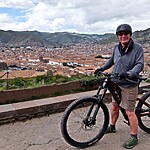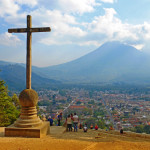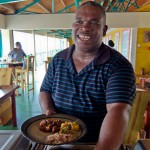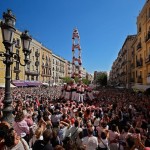Rupert Parker Discovers Mayan Ruins, Classic Colonial Towns And Active Volcanoes In another Insider Guide to Guatemala
Like many of its neighbours in Central America, Guatemala experienced terrible times in the second half of the 20 th century with a civil war that lasted from 1960 to 1996. It was not a place to visit and the scars remained for a long time after the fighting had ceased.
These days the troubles are long over and this is a country rich in culture, history, and natural beauty. From ancient Mayan ruins to vibrant colonial cities, lush rainforests to serene lakes, there’s much to see here. It’s also home to a diverse population, with over 20 indigenous languages spoken. In local markets you’ll find examples of their intricate artistry with handwoven textiles, traditional clothing and other crafts.
Guatemala City

I start in Guatemala City, one big urban sprawl where most travellers head straight to and from the airport. However it’s a cultural hotspot boasting numerous museums and art galleries. The National Museum of Archaeology and Ethnology, recently refurbished, houses the country’s largest collection of ancient Maya artefacts. The Museo Popol Vuh, another must-visit, displays pre-Hispanic figurines, incense burners, burial urns, and carved wooden masks.
Antigua Guatemala
Antigua is a city frozen in time with its cobblestone streets and well-preserved Spanish colonial architecture. It was the capital of the Captaincy General of Guatemala from 1543 until 1773 when the Santa Marta earthquake destroyed much of the town. In 1776, the capital moved to a safer location where Guatemala City now stands.
The buildings left standing after the earthquake led to Antigua’s designation as a UNESCO World Heritage Site in 1979. It’s now a wonderful place to wander on foot, stopping at the many bars and restaurants, admiring the ruined churches. Visit the iconic Arco de Santa Catalina, explore the historic Casa Popenoe, and indulge in the local flavours at the Choco Museo.


Antigua’s vibrant Semana Santa (Holy Week) celebrations are a spectacle not to be missed, with elaborate religious processions and intricate alfombras (carpets) adorning the streets.
Volcán de Pacaya
Volcán de Pacaya, a prominent feature of Guatemala’s volcanic chain, is around 30km from Guatemala City. Eruptions were recorded in the early 16th century and its activity has continued over the years. Dormant for over 70 years, it began erupting vigorously again in 1961. This culminated in a massive eruption on May 27, 2010, when ash rained down on Guatemala City and closed the airport.

Now it’s quiet and the ascent of Pacaya is an exhilarating trek through diverse ecosystems, from dense forests to volcanic slopes blanketed with ash and volcanic rock. You can’t go to the top, for obvious safety reasons, but you get fairly close. The lava fields contain numerous fumaroles, hot vents where guides treat you to roasted marshmallows.
Flores
Flores is a charming island town on Lake Petén Itzá, handy for visits to Petén’s Mayan sites. The architecture reflects a blend of Spanish colonial influences and indigenous Mayan traditions. It’s so tiny that it takes less than an hour to walk all around its shores. Lose yourself in the maze of narrow cobblestone streets lined with quaint shops, vibrant markets, and cosy cafes.


Boat tours explore tranquil Lake Petén Itzá, great for bird watching or spotting the monkeys. For adrenaline junkies, activities such as kayaking, paddle boarding, and even cliff diving are available. Or just jump in the water for a refreshing swim and then watch the sun go down with a cold beer.
Tikal
Guatemala’s history is deeply intertwined with the ancient Mayan civilization, whose impressive ruins are scattered throughout the country. The most famous of these is Tikal, a UNESCO World Heritage Site located just north of Flores. For centuries, this magnificent city lay hidden beneath the thick vegetation, its towering pyramids and intricate temples shrouded in mystery.
As you wander towards the temples and plazas, enveloped by the dense jungle, he air is filled with the sounds of howler monkeys and exotic birds. Suddenly, rising in front of you are majestic pyramids, towering monuments to the Maya’s construction skills. Climbing the steep steps of Temple IV, the tallest structure in Tikal, offers a breath-taking panorama. The surrounding pyramids poke through the lush jungle canopy and give you an idea of the immense scale of the city.


The Great Plaza, with its vast expanse and towering pyramids, served as the epicentre of Tikal’s religious life. Here, priests and shamans once performed elaborate rituals to appease the gods and ensure the prosperity of their civilization.
At its heart stands the Temple of the Grand Jaguar, its imposing facade adorned with intricate stucco masks and carvings.
On the opposite side of the plaza, Temple II, the Temple of the Masks, boasts a series of intricately carved masks depicting the sun god, a testament to the Maya’s reverence for the celestial powers that governed their world. Its graceful twin staircases are adorned with intricate glyphs and symbols.
But for the best experience, get here in the early morning just before dawn, when all is quiet. Take care climbing the stairs in the twilight as the dawn chorus begins. Be in position at the top to watch the sun rise – there’s something magical as the light slowly illuminates the Temple of the Grand Jaguar directly in front of you.

Scattered throughout the countryside around Tikal, there are many other Mayan ruins, some excavated, others left untouched. You can even trek deep into the jungle for days to get to places that other tourists never get to see. However, trudging through the Tikal forest in the dark before sunrise, is more than enough to nourish my own inner Indiana Jones.
Tell Me More About another Insider Guide To Guatemala, Central America
United flies to Guatemala City via the USA from London.
Visit Guatemala has information about another guide to Guatemala and the rest of Guatemala.






